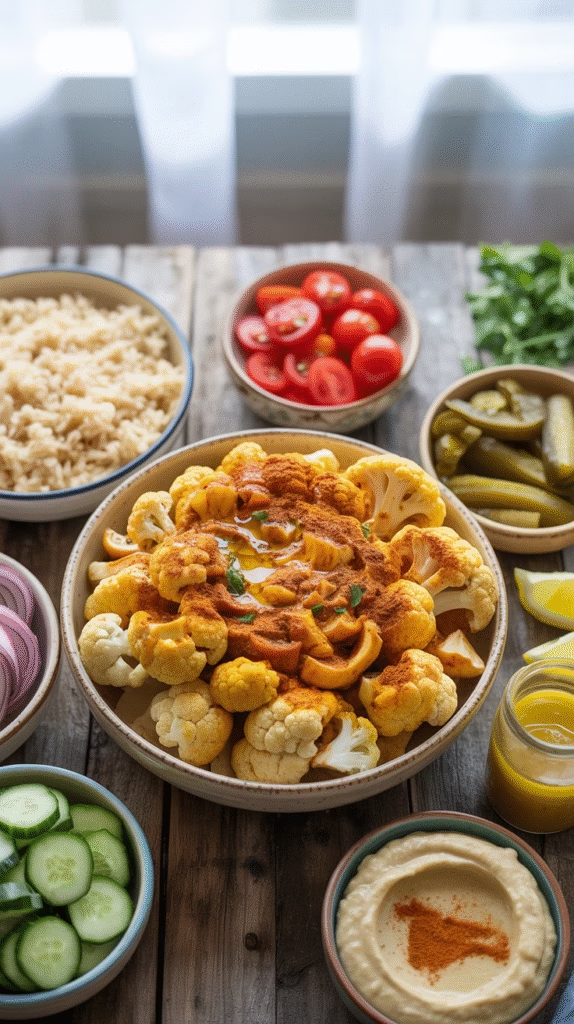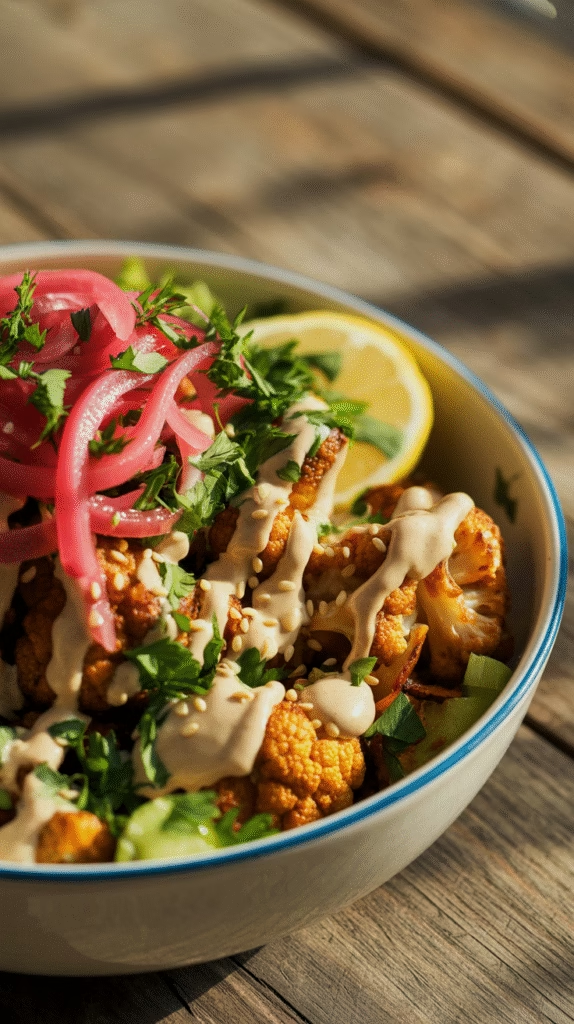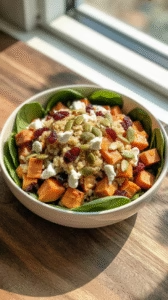Look, I’m gonna be real with you – I used to roll my eyes at cauliflower. That bland, white vegetable that everyone kept trying to convince me was “just as good as rice” or “totally like pizza crust.” Yeah, right. But then I discovered cauliflower shawarma bowls, and honestly? I had to eat my words (pun totally intended). This recipe turned my boring weeknight dinners into something I actually get excited about making.
Why Cauliflower Shawarma Bowls Will Change Your Dinner Game
Ever wondered why some vegetarian dishes leave you feeling like you just ate cardboard, while others make you forget you’re not eating meat? The secret is in the spice blend and cooking technique. Cauliflower shawarma bowls nail both of these elements perfectly.
I stumbled across this recipe during one of those “what the heck am I gonna make for dinner” moments we all know too well. My fridge was practically empty except for a sad-looking cauliflower head that I’d been ignoring for days. Fast forward two hours, and I was practically licking the bowl clean.
The Magic Behind the Method
The genius of cauliflower shawarma lies in how we treat this humble vegetable. We’re not just roasting it and hoping for the best. We’re giving it the full shawarma treatment with:
- Bold Middle Eastern spices that actually penetrate the cauliflower
- High-heat roasting that creates those crispy, caramelized edges
- Strategic oil coating that helps everything stick and sizzle
Trust me, once you smell that cumin, paprika, and garlic combo hitting your oven, you’ll understand why this recipe has become my go-to crowd-pleaser.

Ingredients That Actually Matter
Here’s what you’ll need to make magic happen in your kitchen. I’ve learned the hard way that quality spices make or break this dish, so don’t cheap out on the basics.
For the Cauliflower Shawarma:
- 1 large head cauliflower, cut into bite-sized florets
- 3 tablespoons olive oil
- 2 teaspoons ground cumin
- 2 teaspoons smoked paprika
- 1 teaspoon ground coriander
- 1 teaspoon turmeric
- 1/2 teaspoon cinnamon (trust me on this one)
- 1/2 teaspoon cayenne pepper
- 3 cloves garlic, minced
- 1 teaspoon salt
- 1/2 teaspoon black pepper
For the Bowl Assembly:
- 2 cups cooked quinoa or rice
- 1 cucumber, diced
- 2 tomatoes, chopped
- 1/2 red onion, thinly sliced
- 1/4 cup fresh parsley, chopped
- 1/4 cup fresh mint, chopped
For the Tahini Sauce (Because It’s Mandatory):
- 1/3 cup tahini
- 3 tablespoons lemon juice
- 2 tablespoons water
- 1 clove garlic, minced
- 1/2 teaspoon salt

The Step-by-Step Breakdown That Actually Works
Prepping Your Cauliflower Like a Pro
First things first – preheat your oven to 425°F. I can’t tell you how many times I’ve started cooking only to realize my oven wasn’t ready. Learn from my mistakes, people.
Cut your cauliflower into uniform pieces. I’m talking bite-sized florets that’ll cook evenly. Nobody wants some pieces charred while others are still crunchy (and not in a good way).
In a large bowl, whisk together all your spices with the olive oil and minced garlic. This creates what I like to call the “flavor paste” – it’s gonna coat every single piece of cauliflower and transform it into something incredible.
The Roasting Game-Changer
Toss your cauliflower florets in that spice mixture until they’re completely coated. Don’t be gentle here – get your hands dirty and make sure every piece is covered.
Spread the cauliflower on a large baking sheet in a single layer. This is crucial – overcrowding leads to steaming instead of roasting, and steamed cauliflower is nobody’s friend.
Roast for 25-30 minutes, flipping once halfway through. You’re looking for golden-brown edges and tender centers. The smell alone will have your neighbors asking what’s cooking.
Building Your Bowl Masterpiece
While your cauliflower works its magic in the oven, prep your other components. I like to use this time to make the tahini sauce because multitasking makes me feel productive 🙂
For the sauce, whisk together tahini, lemon juice, water, garlic, and salt until smooth. Start with less water and add more until you reach your desired consistency. Some people like it thick, others prefer it drizzly – you do you.
Assembly: Where Art Meets Hunger
Here’s where you get to be creative. I start with a base of warm quinoa or rice in each bowl. The warmth helps meld all the flavors together beautifully.
Next, add your roasted cauliflower while it’s still hot. This is the star of the show, so don’t be stingy. Arrange your fresh vegetables around the bowl – cucumber, tomatoes, and red onion add that perfect crunch contrast.
Sprinkle fresh herbs generously. Parsley and mint aren’t just garnish here; they’re flavor bombs that brighten the entire dish.
Finally, drizzle that tahini sauce all over everything. Don’t hold back – this sauce ties all the flavors together and adds the creamy element that makes each bite satisfying.
Pro Tips That’ll Make You Look Like a Culinary Genius
Spice Storage Secrets
Store your leftover spice blend in an airtight container. It’ll keep for months and works amazingly on roasted vegetables, grilled chicken, or even popcorn (weird but trust me).
Make-Ahead Magic
You can prep the cauliflower and spice mixture up to a day ahead. Just store it covered in the fridge and roast when you’re ready to eat. The flavors actually develop overnight, making it even better.
Customization Options
IMO, the best part about bowl meals is how adaptable they are. Swap quinoa for bulgur, add roasted chickpeas for extra protein, or throw in some pickled vegetables for tang. I’ve even added feta cheese when I’m feeling fancy.
Troubleshooting Common Mistakes
When Your Cauliflower Turns to Mush
If your cauliflower comes out soggy, you probably didn’t pat it dry after washing or your oven temperature was too low. Moisture is the enemy of good roasting.
Spice Balance Issues
Too salty? Add a squeeze of lemon juice to balance it out. Not flavorful enough? You probably went light on the spices – don’t be afraid to be generous with seasonings.
Tahini Sauce Problems
If your tahini sauce seizes up (gets thick and grainy), just whisk in warm water a tablespoon at a time until it smooths out. This happens when the tahini gets shocked by cold liquid.

Nutritional Perks That Don’t Suck
Let’s be honest – we’re not making this just because it’s healthy, but the nutritional benefits are pretty impressive. Cauliflower packs vitamin C, fiber, and antioxidants while keeping calories low.
The tahini adds healthy fats and protein, while the fresh vegetables contribute vitamins and minerals your body actually needs. It’s one of those rare meals where eating healthy doesn’t feel like punishment.
Storage and Leftover Hacks
Store components separately in the fridge for up to 4 days. The roasted cauliflower actually tastes amazing cold in salads or wraps the next day.
FYI, you can reheat the cauliflower in a 350°F oven for 5-10 minutes to crisp it back up, but honestly, I often eat it straight from the fridge because I’m impatient like that.
Why This Recipe Beats Takeout Every Time
Look, I love ordering shawarma as much as the next person, but making it at home gives you complete control over ingredients and portions. Plus, you’re not spending $15 on what essentially amounts to roasted vegetables and sauce.
The satisfaction of making something this delicious from scratch? Priceless. And when people ask for the recipe (which they will), you get to act all mysterious about your “secret spice blend.”
Final Thoughts: Your Kitchen Will Never Be the Same
This cauliflower shawarma bowl recipe changed how I think about vegetarian cooking. It proved that plant-based doesn’t mean flavor-based. The combination of warm spices, fresh vegetables, and creamy tahini creates something that’s genuinely satisfying, not just “good for a vegetable dish.”
Give this recipe a shot, and I guarantee you’ll add it to your regular rotation. Your taste buds will thank you, your wallet will appreciate the savings, and you’ll have a new go-to dish that impresses everyone without breaking a sweat. Because at the end of the day, isn’t that what good cooking is all about?



